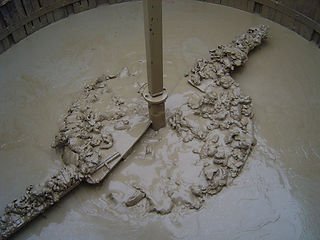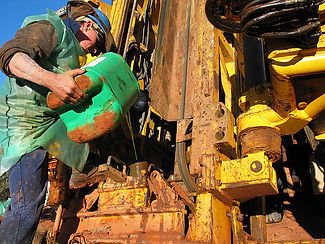
Drilling fluids, also known as drilling muds, play a crucial role in the oil and gas exploration process. These specialized fluids serve multiple purposes, including cooling and lubricating the drill bit, carrying rock cuttings to the surface, and maintaining wellbore stability. In this blog post, we’ll delve into drilling fluids, exploring their types, composition, and various uses in the drilling industry, along with their advantages and disadvantages.
Types of Drilling Fluids:
Drilling fluids come in various types, each tailored to specific drilling conditions and objectives. The primary types of drilling fluids include:
1) Water-Based Mud (WBM):

Water-based muds are the most commonly used drilling fluids and consist of water as the base fluid, along with various additives to enhance performance. These additives may include clays, polymers, and chemical additives to control viscosity, pH, and other properties. Learn more about Water-based muds
Advantages:
– Cost-effective: Generally cheaper than other types of drilling fluids.
– Environmentally friendly: Less harmful to the environment compared to oil-based fluids.
– Versatile: Suitable for a wide range of formations.
Disadvantages:
– Wellbore instability: Can cause issues in water-sensitive formations like shales, leading to wellbore instability.
– Limited temperature tolerance: Less effective in high-temperature environments.
2) Oil-Based Mud (OBM):

Oil-based muds utilize oil, typically diesel or mineral oil, as the base fluid. OBM offers superior lubrication and wellbore stability compared to WBM, making it ideal for drilling in challenging formations such as shale or reactive clays.
However, OBM is more expensive and presents environmental concerns due to its oil content.
Learn more about Oil-based muds
Advantages:
– Wellbore stability: Excellent for drilling through reactive shales and other challenging formations.
– Lubrication: Provides superior lubrication, reducing torque and drag on the drill string.
– Temperature tolerance: More stable at high temperatures.
Disadvantages:
– Environmental concerns: More challenging to dispose of and can be harmful to the environment.
– Cost: More expensive than water-based fluids.
– Health and safety: Requires careful handling due to potential health risks.
3) Synthetic-Based Mud (SBM):

Synthetic-based muds are a hybrid between WBM and OBM, utilizing synthetic oils or esters as the base fluid. SBM offers the benefits of OBM, such as improved lubrication and stability, while also mitigating environmental concerns associated with oil-based fluids. Learn more about Synthetic-Based Mud
Advantages:
– Environmental performance: Generally less harmful than oil-based fluids while offering similar benefits.
– Wellbore stability: Effective in maintaining wellbore stability in challenging formations.
– Lubrication: Provides good lubrication properties.
Disadvantages:
– Cost: Typically more expensive than both water-based and oil-based fluids.
– Complex formulation: Requires precise formulation and handling.
4) Pneumatic Fluids (Air, Gas, Foam):
Advantages:
– Reduced formation damage: Minimizes the risk of formation damage, especially in depleted zones.
– High penetration rates: Can achieve higher drilling speeds in certain formations.
– Minimal environmental impact: Generally less harmful to the environment.
Disadvantages:
– Limited application: Not suitable for all formations, particularly those with high water influx.
– Well control: More challenging to maintain well control compared to liquid-based fluids.
Each type of drilling fluid has its own set of advantages and disadvantages, and the choice depends on the specific requirements of the drilling operation, including the geological formation, environmental considerations, and cost constraints.
Composition of Drilling Fluids:

The composition of drilling fluids varies depending on the type of fluid and specific drilling requirements. However, common components found in drilling fluids include:
a) Base Fluid: Water, oil, or synthetic oils serve as the primary base fluid, providing the foundation for the drilling fluid.
b) Viscosifiers: Clays such as bentonite or polymers are added to increase viscosity and improve suspension of cuttings.
c) Weighting Agents: Barite or hematite may be added to increase the density of the drilling fluid, allowing for control of formation pressures and preventing blowouts.
d) Fluid Loss Control Additives: Chemical additives are incorporated to reduce fluid loss into the formation and maintain wellbore stability.
e) Lubricants: Lubricating agents such as oil-based additives or graphite are included to reduce friction between the drill string and wellbore.
Uses of Drilling Fluids:

Drilling fluids serve several critical functions throughout the drilling process, including:
Cooling and Lubrication: Drilling fluids cool and lubricate the drill bit and drill string, reducing friction and heat generated during drilling.
1 . Cuttings Removal: Drilling fluids transport rock cuttings to the surface, where they can be removed and analyzed to assess formation properties.
2. Formation Protection: Drilling fluids prevent formation damage by stabilizing the wellbore and minimizing fluid invasion into the surrounding rock.
3 . Pressure Control: By adjusting the density and rheological properties of the drilling fluid, engineers can control formation pressures and prevent blowouts.
Conclusion:
Drilling fluids are essential components of the oil and gas drilling process, providing lubrication, cooling, and wellbore stability while facilitating the removal of cuttings and controlling formation pressures.
By understanding the types, composition, and uses of drilling fluids, engineers can optimize drilling operations and ensure safe and efficient well construction.
